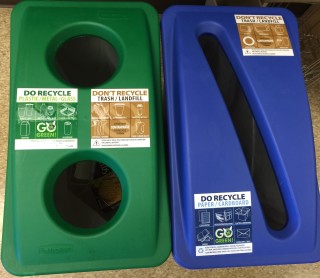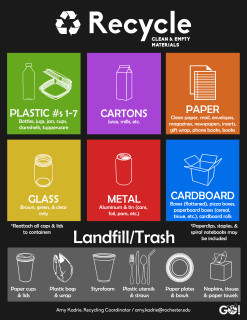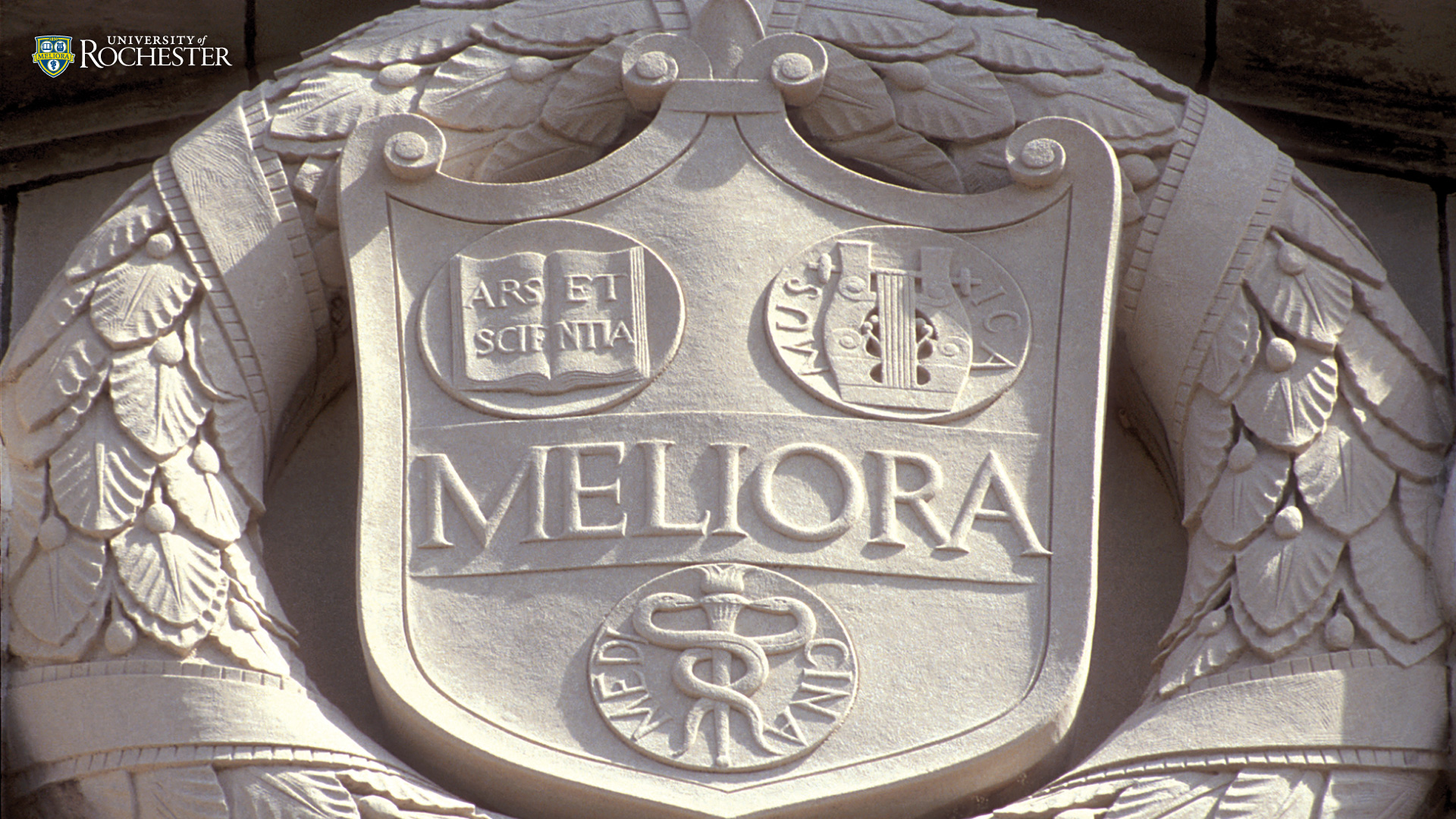As a fresh academic year begins at the University of Rochester, there are some new changes regarding recycling on campus. This past summer, some overall improvements were made as a result of a research project that was conducted, survey feedback received and changes in Monroe County’s recycling program.
The Monroe County Recycling Center has implemented some changes that you should be aware of. Although Monroe County used to require all caps and lids to be detached from containers, now after bottles, jugs, and jars are emptied the caps and lids must be reattached. The facility’s new single stream sorting system has sparked this modification. Since unattached caps and lids are very small and lightweight, they now tend to get caught in the paper recycling stream within the sorting machines, causing contamination as a result. Additionally, plastic utensils and straws are no longer acceptable. The same reason applies to this change, as well as these materials typically being made of low-grade plastics that are not a valuable commodity in the recycling market.
As part of a summer 2105 research internship project conducted by University Facilities and Services, a survey was sent to students and staff to get a better understanding of recycling knowledge and gain insight on the effectiveness of internal communication efforts. The survey was completed by 119 students and 122 employees of the University of Rochester’s River Campus. Information from this survey was then used to make improvements on campus that would be the most productive.
One thing the survey revealed was confusion regarding plastic bags and paper plates being recyclable. To set the record straight, these items are not supposed to be placed in a standard recycle bin. However, plastic bags can be brought to local retail operations to be recycled under the NYS Plastic Bag Reduction, Reuse and Recycling Law. As new signage was needed to include the updates from the county facility, these pieces of information were included as well in effort to get the message out.
 Not surprisingly, the survey revealed that most people get their information on how to recycle on campus from labels and signage, so this was deemed an area worth spending attention on. The survey included several sample signage options to gain insight on which types of signage people thought were the most visually appealing and the easiest to understand. Based on feedback, the recycling signage options that were most appealing and informative were selected and modified to replace the University’s outdated signage. To offer more variety in design and color, three new informational recycling posters are available to download and print at www.rochester.edu/sustainability/recycling/. These posters are framed above key recycling stations in over 150 locations across the River Campus buildings. New labels were also put onto the trio recycling container lids (pictured left) to provide more information on what should and should not go into each bin. These more detailed labels will be coming soon to the School of Medicine and Dentistry as well. To bring home the reality of where non-recyclable items end up, the label “trash/landfill” was used rather than simply “trash” which may perpetuate an “out of sight, out of mind” mentality.
Not surprisingly, the survey revealed that most people get their information on how to recycle on campus from labels and signage, so this was deemed an area worth spending attention on. The survey included several sample signage options to gain insight on which types of signage people thought were the most visually appealing and the easiest to understand. Based on feedback, the recycling signage options that were most appealing and informative were selected and modified to replace the University’s outdated signage. To offer more variety in design and color, three new informational recycling posters are available to download and print at www.rochester.edu/sustainability/recycling/. These posters are framed above key recycling stations in over 150 locations across the River Campus buildings. New labels were also put onto the trio recycling container lids (pictured left) to provide more information on what should and should not go into each bin. These more detailed labels will be coming soon to the School of Medicine and Dentistry as well. To bring home the reality of where non-recyclable items end up, the label “trash/landfill” was used rather than simply “trash” which may perpetuate an “out of sight, out of mind” mentality.

The last decision that was made considering input from the recycling survey this summer was to launch a single stream recycling pilot program in one residential location on campus. As mentioned above, the Monroe County Recycling Center underwent a transition to a single stream recycling system, which means customers no longer need to keep paper and cardboard separate from plastic, metal and glass. But as an important note, trash still needs to go to a landfill and cannot be commingled under this system. The single stream recycling operation is geared towards residential customers. However, Waste Management, the facility’s operator and the University’s hauler, is allowing an exception to be made on the River Campus, which is partially residential.
As single stream recycling does not require the sorting of recyclable materials, it can improve the convenience of recycling and thus increase the volume of recyclables collected. But there are a growing number of studies concluding that single stream is not always the best system. Some of the cons of a single stream recycling system are an increased level of contamination and a decreased value of recyclable commodities which has a ripple effect on rebates received.
As part of deliberating whether or not single stream recycling was a good fit for our campus, the summer survey somewhat surprisingly revealed that a switch from dual stream to single stream recycling on campus would not have a highly significant impact on making people more likely to recycle on campus. However, residential areas of campus would be most desirable place to implement this change for multiple reasons, including decreased cost, decreased contamination, and material types generated in these areas being more desirable for single stream collection compared to other locations on campus. The pilot program affects only students living in the Susan B. Anthony residence halls and will serve as a test to gather information on how well single stream can work in a residential location on the River Campus. The collection containers on the residential wings of the building have been relabeled for single stream collection, and this pilot will be used as a benchmark for other possible single stream locations on campus in the future.
You can view the full results of the 2015 River Campus Recycling Survey here.
If you are missing recycling containers or labels in your area, please contact recycling coordinator Amy Kadrie (amy.kadrie@rochester.edu).
Please visit the newly updated recycling webpages via the University of Rochester sustainability webpage and learn more about recycling programs offered at the University of Rochester.
Written by Mariah Greico, Class of 2018

